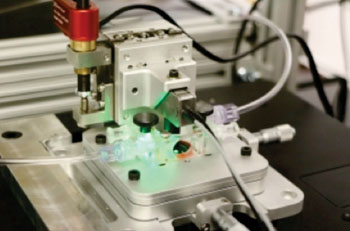Breakthrough DNA Analysis Technology to Hasten Problem Diagnosis
By LabMedica International staff writers
Posted on 25 Aug 2014
Researchers have achieved a technical breakthrough that should result in speedier diagnosis of diseases for which analysis of DNA from single-cells is critical, such as early stage cancers and various prenatal conditions. Posted on 25 Aug 2014
The key discovery lies in a new tool developed by a team led by Sabrina Leslie and Walter Reisner, both professors of physics at McGill University (Montreal, QC, Canada), and their collaborator Dr. Rob Sladek of the McGill University & Génome Québec Innovation Center (MUGQ Innovation Center; Montreal, Quebec, Canada). The tool enables the loading of long strands of DNA into a tunable nanoscale imaging chamber in ways that maintain structural identity and conditions similar to their in vivo physiology. This breakthrough method – “Convex Lens-Induced Confinement” (CLIC) (also referred to as convex lens-induced nanoscale templating (CLINT)) – will permit a rapid imaging-based mapping of large genomes while simultaneously identifying specific gene sequences from single cells with single-molecule resolution, a process critical to diagnosing certain types of diseases.

Image: A technical breakthrough for DNA imaging has been achieved that should quicken diagnosis of diseases for which analysis of DNA from single-cells is critical, such as early stage cancers and various pre-natal conditions (Photo courtesy of McGill University and Génome Québec Innovation Center).
Existing tools used for single-cell genomic analysis rely on side-loading DNA and under pressure into nanochannels in the imaging chamber, a practice that breaks the DNA molecules into small pieces, making it a challenge to later reconstruct the genome. The CLIC tool can be set on top of a standard inverted fluorescence microscope and its innovative aspect lies in the fact that it allows strands of DNA to be loaded into the imaging chamber – from above – and in a process that allows the strands of DNA to maintain their integrity.
“It’s like squeezing many soft spaghetti noodles into long narrow tubes without breaking them,” explains Prof. Leslie, “Once these long strands of DNA are gently squeezed down into nanochannels from a nanoscale bath above, they become effectively rigid which means that we can map positions along uniformly stretched strands of DNA, while holding them still. This means diagnostics can be performed quickly, one cell at a time, which is critical for diagnosing many prenatal conditions and the onset of cancer.”
“Current practices of genomic analysis typically require tens of thousands of cells worth of genomic material to obtain the information we need, but this new approach works with single cells,” said Dr. Sladek, “CLIC will allow researchers to avoid having to spend time stitching together maps of entire genomes as we do under current techniques, and promises to make genomic analysis a much simpler and more efficient process.”
“Nanoscale physics has so much to offer biomedicine and diagnostics,” added Prof. Leslie, “CLIC brings the nanoscale regime to the bench top, and genomics is just the beginning”.
The work was described by Berarda DJ et al. in the journal Proceedings of the National Academy of Sciences of the United States of America (PNAS), August 4, 2014, online ahead of print.
Related Links:
McGill University
The McGill University and Génome Québec Innovation Center













